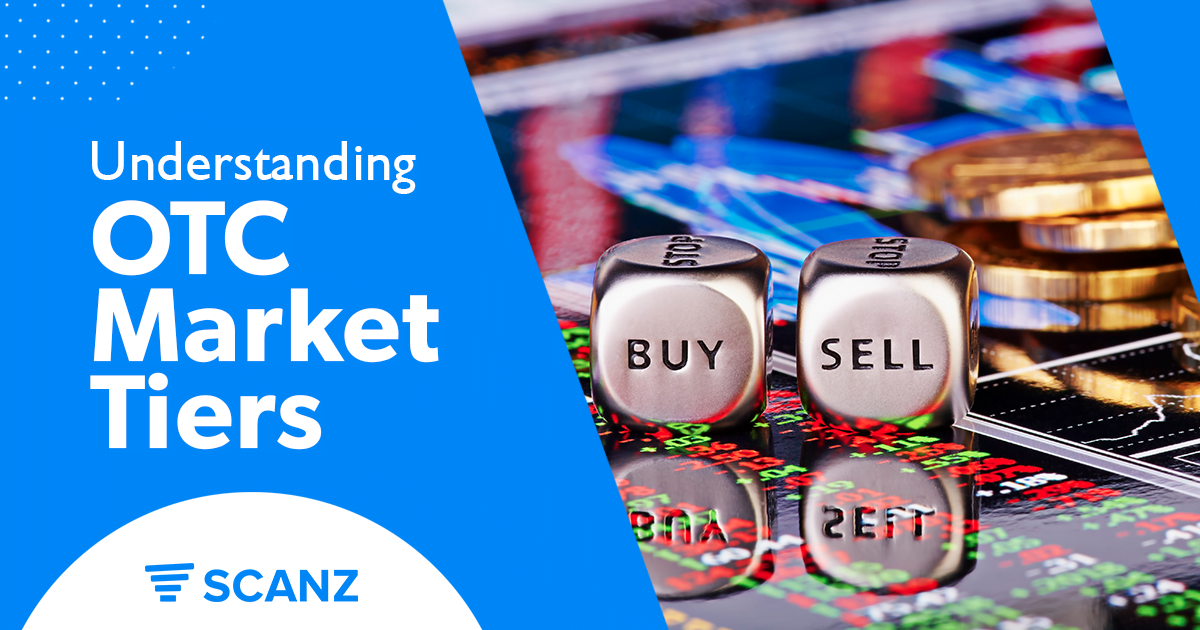OTC markets are popular among traders looking for penny stocks and microcap stocks that don’t trade on the major exchanges. However, these markets lack some of the safeguards of stock exchanges and OTC stocks often don’t have the same level of regulatory scrutiny as exchange-traded stocks.
So, it’s important to understand how OTC markets work, what the different OTC market tiers are, and what the classifications that are given to OTC stocks mean.

What are the OTC Markets?
OTC, or over-the-counter, markets are decentralized stock markets where individuals buy and sell stocks directly with each other. Typically, the term OTC markets refers to the specific decentralized markets run by The OTC Markets Group, a for-profit financial markets provider.
OTC markets are typically home to penny stocks and micro-cap stocks that don’t meet the stringent listing requirements of major US exchanges. Some well-known foreign companies, like Nestle, Volkswagen, and Samsung, also trade on OTC markets in order to avoid costly US exchange regulations.

OTC Markets vs. Other Exchanges
OTC markets operate very differently from other exchanges. First, they are fully electronic and do not have physical locations. Buy and sell orders are matched automatically or by dealers, and the prices at which transactions occur are not always visible to everyone in the market.
As a result of this system, liquidity is frequently low in OTC markets. Prices can swing wildly throughout the day, particularly compared to major exchanges. Particularly for penny stocks, it can be difficult to enter or exit positions quickly.
Another important difference between OTC markets and other exchanges is in how they are regulated. OTC markets are subject to much less oversight by the SEC than major exchanges, and there are fewer rules around what information companies must report. It’s critical that you do your own research when buying stocks on OTC markets, especially since some smaller companies have been known to exaggerate or misstate financial information for investors.
OTC Market Tiers

The OTC Markets Group platform is divided into three distinct marketplaces: OTCQX, OTCQB, and OTC Pink.
OTCQX
The OTCQX market has the strictest regulatory and reporting requirements of the three OTC market tiers. In order to list on this marketplace, companies must report to the SEC, disclose material news to investors, and be sponsored by a third-party such as a bank or investment firm. In addition, companies on the OTCQX market must meet revenue, stock price, and market cap minimums.
Given these stringent requirements, stocks on the OTCQX markets are considered more trustworthy and typically have more liquidity than those on the lower market tiers.
OTCQB
The OTCQB market is a step down from the OTCQX market in terms of what is required of companies in order to list shares. Companies must be audited annually, report to the SEC or a banking regulator, and must have a minimum share price of $0.01. These companies must also have a float of at least 10% of outstanding shares.
This marketplace includes many companies that are growing and need access to public markets for capital, but don’t yet have the capacity to meet the reporting or revenue requirements of the OTCQX marketplace.
OTC Pink
The OTC Pink market, also known as the ‘Pink Sheets,’ is the least regulated OTC market. Companies on the OTC Pink market do not have to be audited, although they must report to the SEC. They must also file a form with FINRA in order to list.
Companies on the OTC Pink marketplace are often penny stocks, shell companies, and companies that are in financial distress. Be cautious of scams when trading stocks in this market.
Other OTC Market Classifications

Stocks on the three OTC market tiers are classified in several additional ways that indicate their current status or to provide warnings to potential investors. Typically, these classifications are visibly listed on The OTC Markets Group page for a particular stock.
Delinquent SEC Reporting
A delinquent SEC reporting classification indicates that a company is not up to date with its SEC reporting requirements under the Exchange Act. Companies that are delinquent may be subject to removal from the OTC markets by the SEC until reporting requirements are fulfilled. In other words, a company that falls behind on its reporting may have trading of its shares suspended.
Shell Risk
The OTC Markets Group may classify a company as a Shell Risk if the company has financial or other characteristics of a shell company. This classification is assigned subjectively based on a company’s financial disclosures and is not based on companies’ self-reported shell status. Shell companies can be problematic for investors because they hide the underlying company’s financial activity and changes in operations.
Dark or Defunct
Companies labeled as Dark or Defunct are those that have failed to provide any public financial updates, either to the SEC or to The OTC Markets Group.
Caveat Emptor
The Caveat Emptor classification is a public warning to investors issued by The OTC Markets Group. This designation indicates that the company has been associated with fraudulent or potentially illegal activity or has a pending suspension of trading by regulators.
Conclusion
The OTC markets are where the shares of thousands of startups, micro-cap companies, and foreign companies trade. Understanding the three different OTC market tiers can help you evaluate the risk of a particular stock and gauge the stock’s regulatory oversight and liquidity. When trading stocks on the OTC market, be sure to look for classifications by The OTC Markets Group that may provide additional information about a company’s regulatory status.








